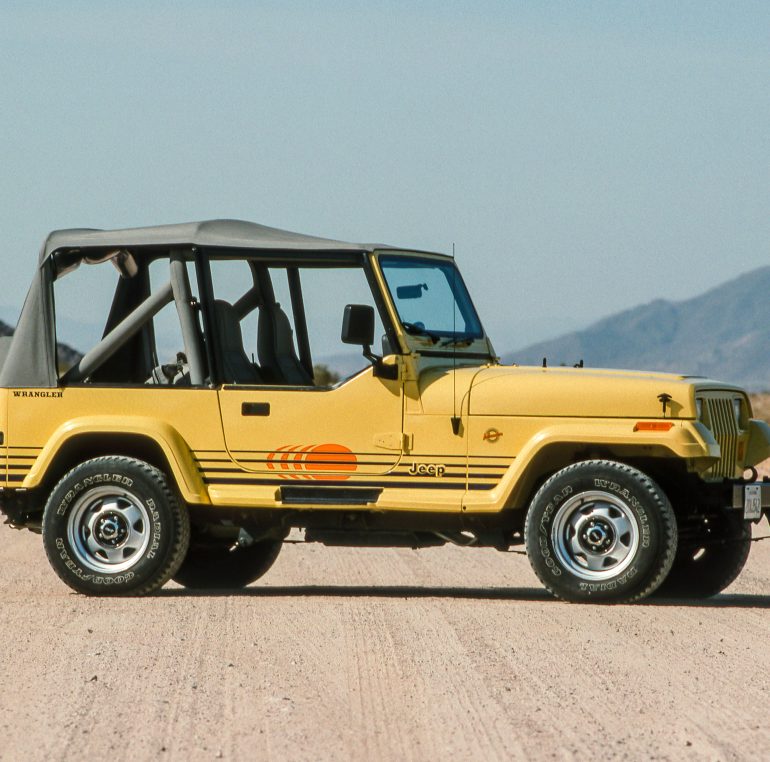The 1988-1993 Jeep Wrangler Islander: An In-Depth Exploration of a Unique Off-Road Icon
The Jeep Wrangler Islander, produced between 1988 and 1993, stands out as a unique and colorful chapter in the history of Jeep’s iconic off-road vehicles. Designed to capture the spirit of fun and adventure, the Islander edition added a distinct flair to the rugged capability and versatility of the YJ Wrangler series. This article delves into the design, engineering, performance, features, and overall impact of the 1988-1993 Jeep Wrangler Islander.
Design and Exterior
The Jeep Wrangler Islander was instantly recognizable due to its distinctive and vibrant exterior styling. Available in a range of bright colors such as Bright Red, Teal, and Pacific Blue, the Islander edition embraced a more playful and adventurous aesthetic compared to the standard Wrangler models. One of the most striking features was the Islander decal package, which included colorful graphics and palm tree logos on the hood and sides of the vehicle, reinforcing its beach and island theme.
The Islander maintained the YJ series’ signature design elements, such as the rectangular headlights, seven-slot grille, and boxy shape, which honored Jeep’s military heritage while providing a modern and refined look. The body-on-frame construction ensured durability and strength, essential for off-road adventures. The Islander edition also featured full or half doors and a choice of hardtop or soft top, offering versatility for different weather conditions and driving experiences.
Interior and Comfort
Inside, the Jeep Wrangler Islander focused on enhancing comfort and practicality while maintaining its rugged charm. The interior was designed with functionality in mind, featuring durable materials that could withstand the rigors of off-road driving. The Islander edition added unique touches such as special seat upholstery with colorful patterns, further differentiating it from other Wrangler models.
The dashboard layout was straightforward and user-friendly, with easy-to-read gauges and accessible controls. The Islander edition included convenient storage options such as a center console, door pockets, and improved climate control, making it suitable for both daily commuting and adventurous getaways. The rear seat option allowed the Wrangler Islander to accommodate up to four passengers, with the ability to fold down or remove the rear seat entirely for additional cargo space.
Performance and Capabilities
The Jeep Wrangler Islander offered robust engine options to meet various driving needs. The most common engine was the 4.2-liter AMC inline-six engine, known for its durability and performance, producing around 112 horsepower and 210 lb-ft of torque. In 1991, the 4.2-liter engine was replaced by the more powerful 4.0-liter inline-six engine, which produced 180 horsepower and 220 lb-ft of torque. Additionally, a 2.5-liter AMC inline-four engine was available, producing 117 horsepower and 135 lb-ft of torque. These engines were paired with either a five-speed manual transmission or a three-speed automatic transmission, giving drivers the flexibility to choose their preferred driving experience.
The YJ’s suspension system, featuring leaf springs with track bars and sway bars, balanced off-road capability with on-road comfort. The solid front and rear axles, combined with high ground clearance, allowed the Wrangler Islander to navigate challenging terrains with ease, from rocky trails to sandy beaches. The five-speed manual transmission and the optional three-speed automatic transmission provided drivers with flexibility in their driving experience.
Technological and Safety Features
The 1988-1993 Jeep Wrangler Islander incorporated several safety and technological features to enhance the driving experience. The vehicle came equipped with front disc brakes and rear drum brakes, providing reliable stopping power. Power steering was available as an option, improving maneuverability, especially in tight spots and off-road trails.
In terms of technology, the Islander offered an optional AM/FM stereo with a cassette player, a notable upgrade for the time. This feature allowed drivers to enjoy music and stay entertained during their journeys. The vehicle’s instrumentation included a tachometer, speedometer, fuel gauge, and temperature gauge, ensuring that drivers had essential information at their fingertips.
Legacy and Impact
The 1988-1993 Jeep Wrangler Islander played a crucial role in establishing the YJ series as a versatile and appealing off-road vehicle. By adding a touch of fun and adventure to the rugged capability of the Wrangler, the Islander edition attracted a new audience of drivers who were looking for both style and substance. The unique design elements and vibrant colors made the Islander a standout model in the Jeep lineup, creating a lasting impression and a loyal following.
The Islander edition also helped to expand the Wrangler’s appeal beyond traditional off-road enthusiasts, attracting urban drivers and beachgoers who appreciated its distinctive style and practical features. The combination of rugged performance and playful design made the Islander a popular choice for a wide range of activities, from daily commuting to weekend getaways.
Conclusion
The 1988-1993 Jeep Wrangler Islander represents a unique and memorable chapter in the history of Jeep’s iconic off-road vehicles. By blending rugged design, enhanced comfort, and playful aesthetics, the Islander edition captured the spirit of adventure and fun, appealing to a broader audience of drivers. The Islander’s legacy endures as a testament to Jeep’s commitment to innovation and its dedication to the adventurous spirit of its drivers. Today, the Jeep Wrangler continues to be a symbol of freedom, exploration, and resilience, with the 1988-1993 Islander model standing as a significant and beloved part of its storied history.

